This is “Résumés and Cover Letters”, section 20.3 from the book Communication for Business Success (Canadian Edition) (v. 1.0). For details on it (including licensing), click here.
For more information on the source of this book, or why it is available for free, please see the project's home page. You can browse or download additional books there. To download a .zip file containing this book to use offline, simply click here.
20.3 Résumés and Cover Letters
Learning Objectives
- Describe the differences among functional, reverse chronological, combination, targeted, and scannable résumés.
- Discuss what features are required in each type of résumé.
- Prepare a one- or two-page résumé.
- Prepare a one-page cover letter.
A résuméDocument that summarizes your education, skills, talents, employment history, and experiences in a clear and concise format for potential employers. is a document that summarizes your education, skills, talents, employment history, and experiences in a clear and concise format for potential employers. The résumé serves three distinct purposes that define its format, design, and presentation:
- To represent your professional information in writing
- To demonstrate the relationship between your professional information and the problem or challenge the potential employer hopes to solve or address, often represented in the form of a job description or duties
- To get you an interview by clearly demonstrating you meet the minimum qualifications and have the professional background to help the organization meet its goals
An online profile page is similar to a résumé in that it represents you, your background and qualifications, and adds participation to the publication. People network, link, and connect in new ways via online profiles or professional sites like LinkedIn. In many ways, your online profile is an online version of your résumé with connections and friends on public display. Your Twitter account and Facebook page are also often accessible to the public, so never post anything you wouldn’t want your employer (current or future) to read, see, or hear. This chapter covers a traditional résumé, as well as the more popular scannable features, but the elements and tips could equally apply to your online profile.
Focus on Accomplishments, Not Tasks
The most effective résumés will focus on your accomplishments, not just the positions you held. Your résumé should point out your strengths. Use dynamic verbs (see “101 Action Verbs” below).
101 Action Verbs
Here are the kinds of verbs that help “sell” you to potential employers. Expand on this list to find good verbs specific to your accomplishments by doing an Internet search for “action verbs for résumés.”
| acted | delegated | implemented | persuaded |
| adapted | demonstrated | improved | planned |
| advised | designed | increased | prepared |
| analyzed | developed | influenced | prioritized |
| arranged | devised | informed | produced |
| assembled | diagnosed | initiated | promoted |
| assessed | directed | inspected | publicized |
| assigned | edited | instituted | recruited |
| attained | educated | instructed | rehabilitated |
| authored | enabled | integrated | represented |
| balanced | encouraged | introduced | researched |
| budgeted | engineered | invented | reviewed |
| built | enlisted | investigated | revitalized |
| calculated | established | lectured | scheduled |
| chaired | evaluated | managed | set goals |
| coached | executed | marketed | shaped |
| collected | fabricated | mediated | solved |
| communicated | facilitated | moderated | spoke |
| compiled | forecasted | motivated | stimulated |
| computed | formulated | negotiated | strengthened |
| conceptualized | founded | organized | supervised |
| consolidated | generated | originated | trained |
| contracted | guided | overhauled | translated |
| coordinated | identified | oversaw | upgraded |
| counselled | illustrated | performed | wrote |
| created |
Source: Beiderwell, B., Tse, L., Lochhaas, T., & deKanter, N. (1999). College Success Irvington, NY: Flat World Knowledge.
The most effective accomplishments are quantifiable: include numbers. Be sure to include dollar amounts and percentages that support your achievements. For example, you might write “Reduced costs by 20 percent.” Your résumé should be a living document; any time you accomplish something of significance, note it in the current version of your résumé so you don't have to struggle to recall it at a later date.
Sometimes, though, we don't have numbers. We aren't told about them or it's too difficult to quantify your success. In those cases, focus on the skills you developed in that experience. Did you improve your time management skills? Did you develop excellent leadership skills? Did you polish your customer service or communication skills?
Main Parts of a Résumé
Deciding what to include in your résumé is where most of the work comes in, because it is in the careful wording of the body of your résumé that you can really sell yourself for a position. Ideally, you should review your résumé for each position you are applying for, particularly to include any accomplishments that you would not include in your “general résumé” but that are relevant to that particular job.
Regardless of the format, employers have expectations for your résumé. They expect it to be clear, accurate, and up to date.Bennett, S. A. (2005). The elements of résumé style: Essential rules and eye-opening advice for writing résumés and cover letters that work. AMACOM. This document represents you in your absence, and you want it to do the best job possible. Unfortunately, too often a résumé is a reason to exclude a candidate. Poor grammar, misspelled words, lengthy listings of irrelevant experience, and messy formatting motivate hiring managers to move quickly to the next candidate.
You don’t want to be represented by spelling or grammatical errors, as they may raise questions about your education and attention to detail. Someone reading your résumé with errors will only wonder what kind of work you might produce that will poorly reflect on their company. There is going to be enough competition that you don’t want to provide an easy excuse to toss your résumé at the start of the process. Do your best work the first time.
Résumés can be quite subjective. Although there is no such thing as a perfect format for a résumé, there are several basic elements that employers look for, including your contact information, a summary of qualifications, education and work experience. You may also include an objective statement, volunteer experience, and so on. Each résumé format may organize the information in distinct ways based on the overall design strategy, but all information should be clear, concise, and accurate.Simons, W., & Curtis, R. (2004). The Résumé.com guide to writing unbeatable résumés. New York, NY: McGraw-Hill.
Contact Information
This section is often located at the top of the document. The first element of the contact information is your name. You should use your full, legal name even if you go by your middle name or use a nickname. There will plenty of time later to clarify what you prefer to be called, but all your application documents, including those that relate to payroll, your social security number, drug screenings, background checks, fingerprint records, transcripts, certificates or degrees, should feature your legal name. Other necessary information includes your address, your primary phone number (cell or landline), and e-mail address. You should also consider including an up-to-date LinkedIn account or personal Web page if those online sources highlight your accomplishments and represent you professionally. If you maintain two addresses (e.g., a campus and a residential address), make it clear where you can be contacted by indicating the primary address. For business purposes, do not use an unprofessional e-mail address like sexiluvr93@hotmale.com or tutifruti@yafoo.com. Create a new e-mail account if needed with an address suitable for professional use.
Figure 20.1 Sample Contact Information
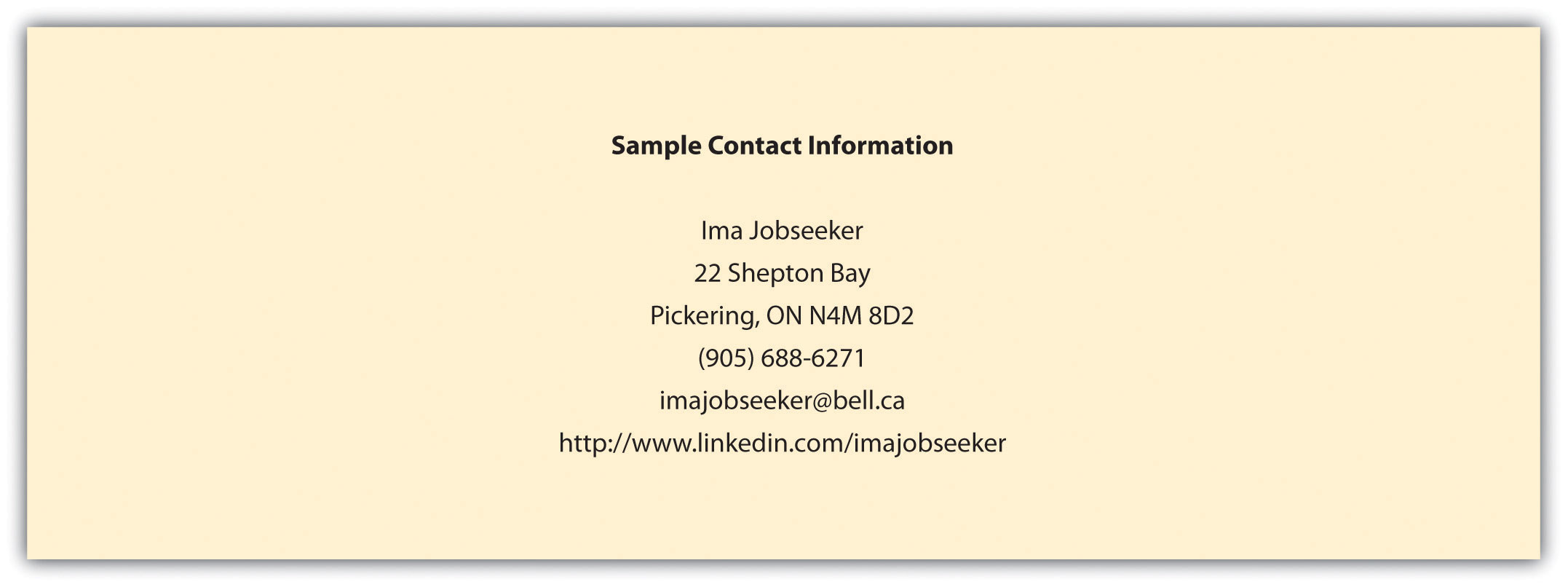
Profile or Summary of Qualifications
The profile or summary of qualifications answers the question, "Why should you hire me?" It summarizes the résumé in 3-4 bullets or sentences, and provides an "executive summary" of your document. This section presents your best qualities as they align with the requirements of the job ad.
Figure 20.2 Sample Profile/Summary of Qualifications
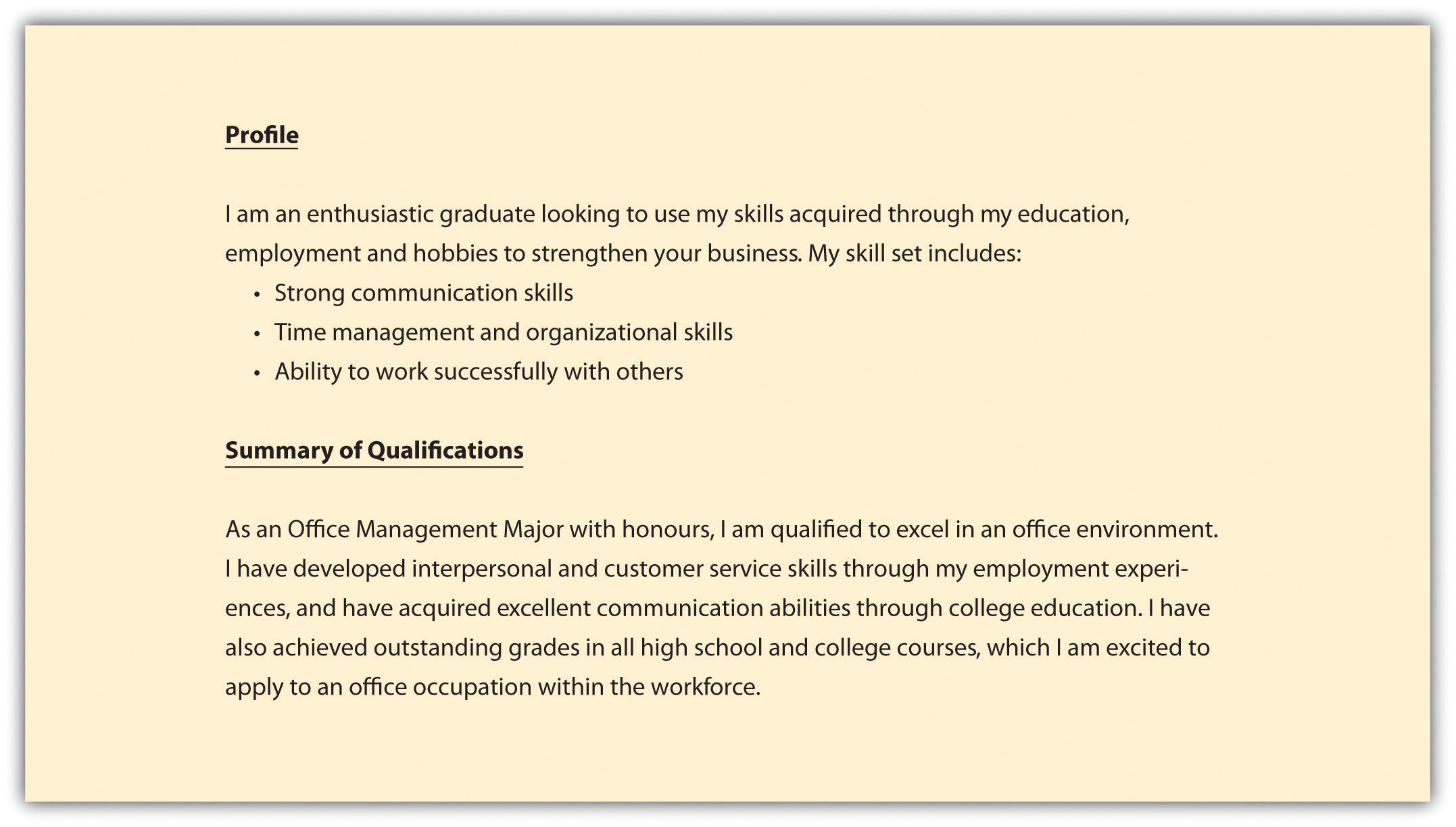
Objective (Optional)
Hiring managers are generally divided on the use of an objective statement. Many find it redundant because they know what your objective is: to get the job!
Having said that, many applicants still have the need to include one. If you insist on doing so, your objective should reflect the audience’s need to quickly understand how you will help the organization achieve its goals.
Figure 20.3 Sample Objective

Education
You need to list your education in reverse chronological order, with your most recent degree first. List the school, degree, and the year of completion. If your education is still in progress, say so, perhaps including an anticipated graduation date. Only list education that you completed or is still in progress; if you went to a specific university or college for a year but left because it "wasn't for you" then you don't list it on the résumé.
You may want to add your overall grade point average (GPA) if you are proud of that number. You may also want to list grades in your major courses to demonstrate your success in your chosen field. You may also want to highlight relevant coursework that directly relate to the position.
In general, follow the five-year rule when considering the addition of your high school education. If you graduated high school within the last five years then feel free to include it on your résumé. Once you've graduated college or university then you should consider removing the high school information; hiring managers will assume you graduated high school once your college or university degree is listed.
Figure 20.4 Sample Education Field
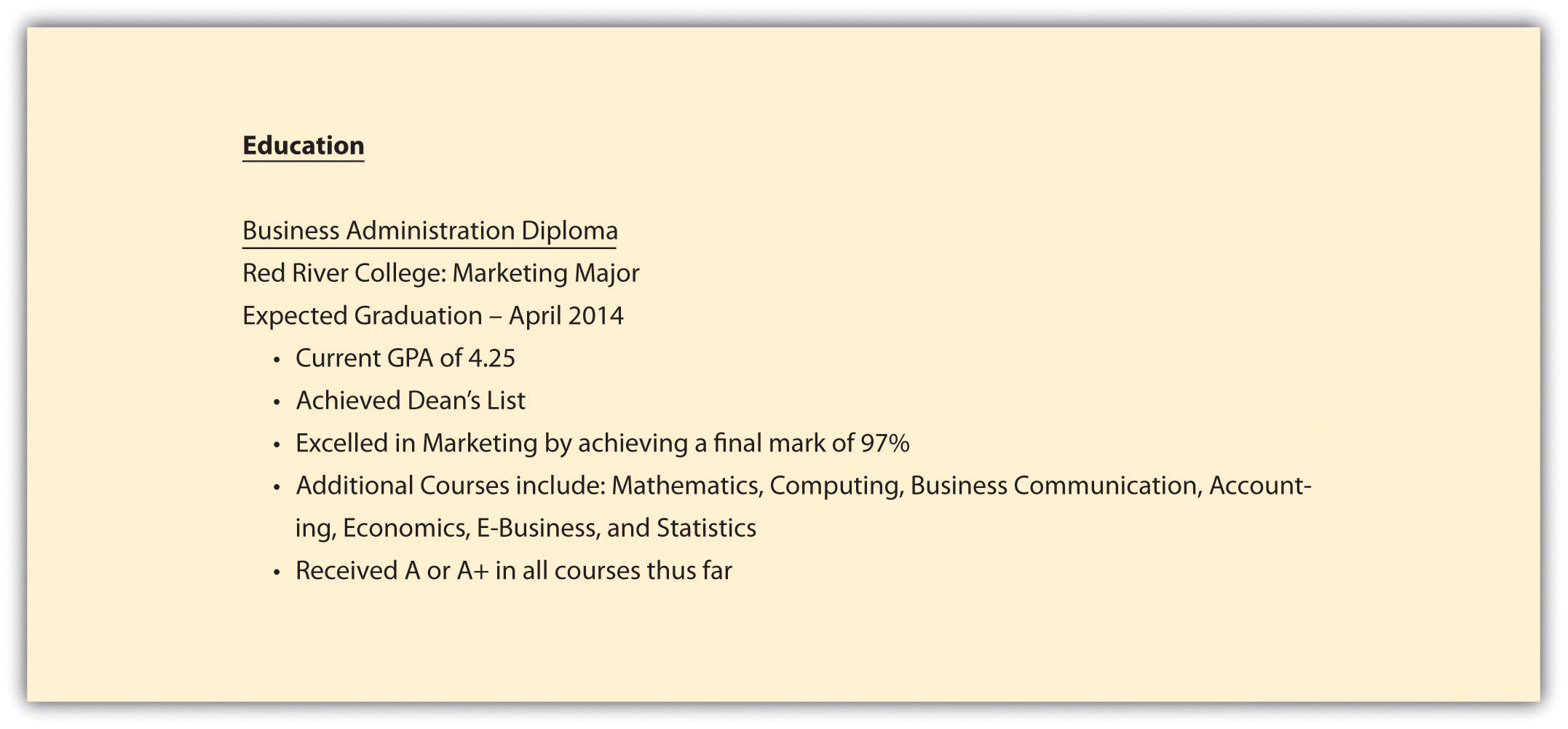
Work Experience
List in reverse chronological order your employment history, including the positions, companies, locations, and dates. Use bulleted lists to describe your accomplishments, and skills demonstrated or acquired. You may also consider a bullet that succinctly describes your duties.
Ensure you emphasize quantifiable accomplishments and responsibilities that match your strengths to the requirements of the job. Often this involves communication, budgets, teamwork, supervision, and customer service when applying for positions in business and industry, but don’t let emphasis become exaggeration. This document represents you in your absence, and if information is false, at a minimum you could lose your job.
Figure 20.5 Sample Work Experience
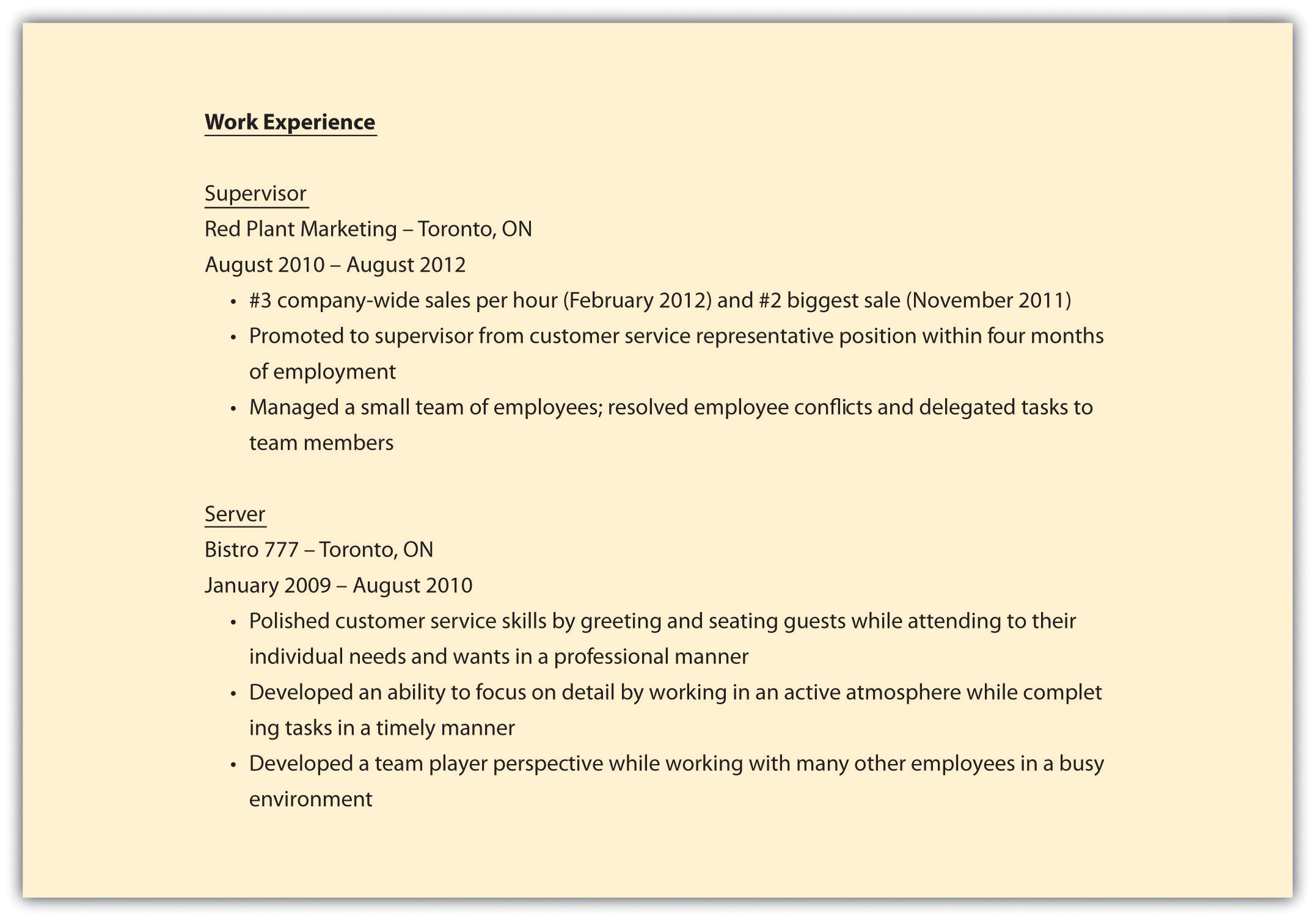
Table 20.1 Types of Résumés
| Type | Function | Advantage | Disadvantage |
|---|---|---|---|
| 1. Reverse Chronological | Reverse chronological résumés (also called reverse time order) focus on work history. | Demonstrates a consistent work history | It may be difficult to highlight skills and experience. |
| 2. Functional | Functional résumés (also called competency-based résumés) focus on skills. | Demonstrates skills that can clearly link to job functions or duties | It is often associated with people who have gaps in their employment history. |
| 3. Combination | A combination résumé lists your skills and experience first, then employment history and education. | Highlights the skills you have that are relevant to the job and provides a reverse chronological work history | Some employers prefer a reverse chronological order. |
| 4. Targeted | A targeted résumé is a custom document that specifically highlights the experience and skills that are relevant to the job. | Points out to the reader how your qualifications and experience clearly match the job duties | Custom documents take additional time, preparation, analysis of the job announcement, and may not fit the established guidelines. |
| 5. Scannable | A scannable résumé is specifically formatted to be read by a scanner and converted to digital information. | Increasingly used to facilitate search and retrieval, and to reduce physical storage costs | Scanners may not read the résumé correctly. |
Do not include references at the end of your résumé. And while many people are tempted to include a “references upon request” line, even that statement is considered redundant. Of course they're available on request! If the hiring manager makes that request, you're absolutely going to provide them!
Experts are also divided on résumé length. Some suggest you should never extend your résumé to more than one page, but it all depends on who you are and what experiences and skills you have acquired. If a one-page résumé provides a good snapshot as to who you are at this point in time without seeming like it's skimping on the details, then great! But if it looks like you've chopped so much out just to get it to one page and the hiring manager can't see your skills and accomplishments, then that's not so good.
If you've got a lot of relevant skills, accomplishments and experiences, then a two-page résumé is totally fine. If it looks like you're padding your résumé with irrelevant information just to get it to two pages, then that's not so good.
Don't focus on length; ensure the résumé provides the reader with the relevant details that highlight your skills and accomplishments. Remember, you may never get a second chance to make a good first impression.
Maximize Scannable Résumé Content
Use Key Words
Just as there are common search terms, and common words in relation to each position, job description, or description of duties, your scannable résumé needs to mirror these common terms. Use of nonstandard terms may not stand out, and your indication of “managed employees” may not get the same attention as the word “supervision” or “management.”
Follow Directions
If a job description uses specific terms, refers to computer programs, skills, or previous experience, make sure you incorporate that language in your scannable résumé. You know that when given a class assignment, you are expected to follow directions; similarly, the employer is looking for specific skills and experience. By mirroring the employer’s language and submitting your application documents in accord with their instructions, you convey a spirit of cooperation and an understanding of how to follow instructions.
Insert a Key Word Section
Consider a brief section that lists common words associated with the position as a skills summary: customer service, business communication, sales, or terms and acronyms common to the business or industry.
Make It Easy to Read
You need to make sure your résumé is easy to read by a computer, including a character recognition program. That means no italics, underlining, shading, boxes, or lines. Choose a sans serif (without serif, or decorative end) font like Arial or Tahoma that won’t be misread. Simple, clear fonts that demonstrate no points at which letters may appear to overlap will increase the probability of the computer getting it right the first time. In order for the computer to do this, you have to consider your audience—a computer program that will not be able to interpret your unusual font or odd word choice. A font size of eleven or twelve is easier to read for most people, and while the computer doesn’t care about font size, the smaller your font, the more likely the computer is to make the error of combining adjacent letters.
Printing, Packaging and Delivery
Use a laser printer to get crisp letter formation. Inkjet printers can have some “bleed” between characters that may make them overlap, and therefore be misunderstood. Folds can make it hard to scan your document. E-mail your résumé as an attachment if possible, but if a paper version is required, don’t fold it. Use a clean, white piece of paper with black ink; colours will only confuse the computer. Deliver the document in a nine-by-twelve-inch envelope, stiffened with a sheet of cardstock (heavy paper or cardboard) to help prevent damage to the document.
Figure 20.6 Sample Format for Chronological Résumé
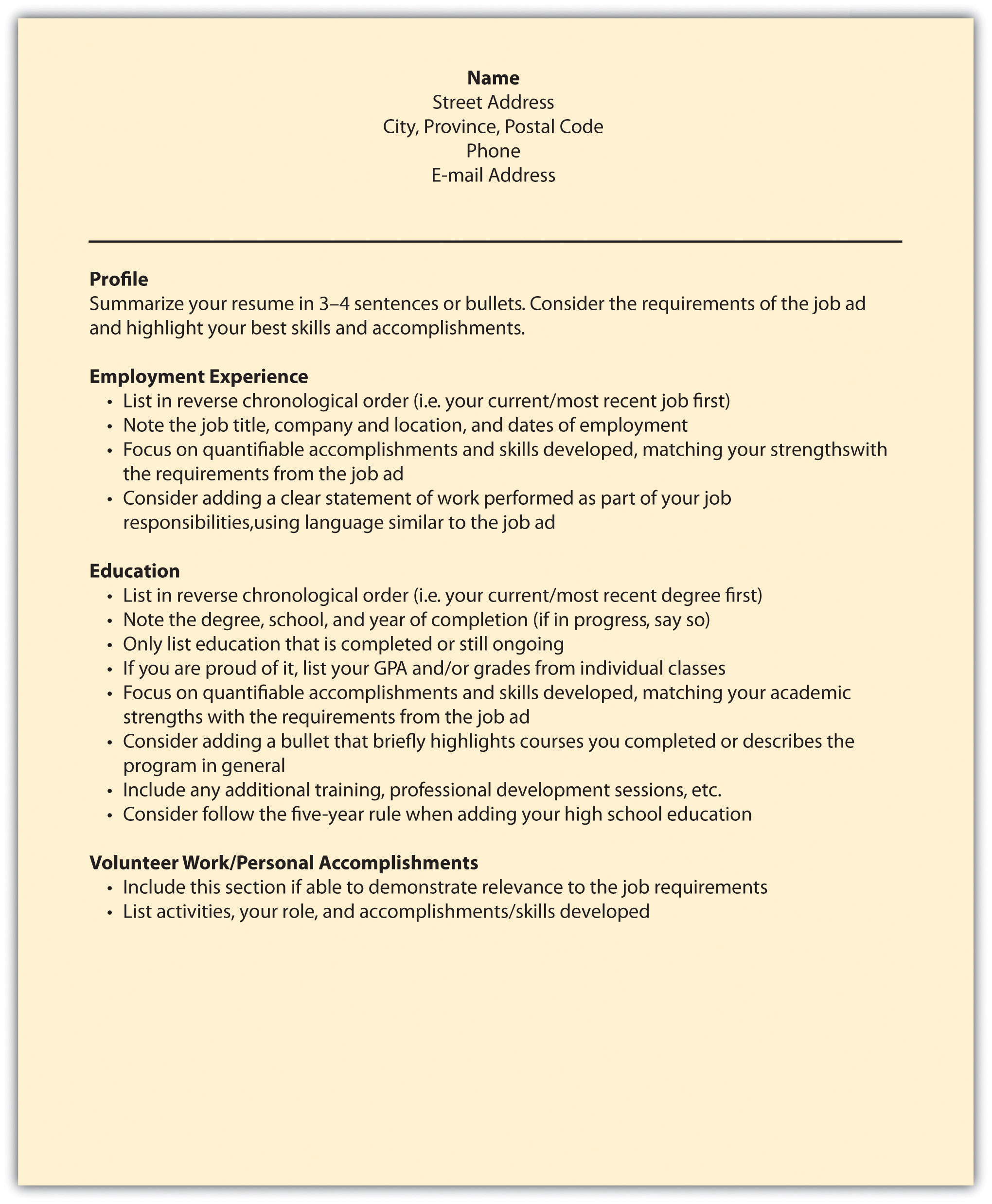
Figure 20.7 Sample Format for Functional Résumé
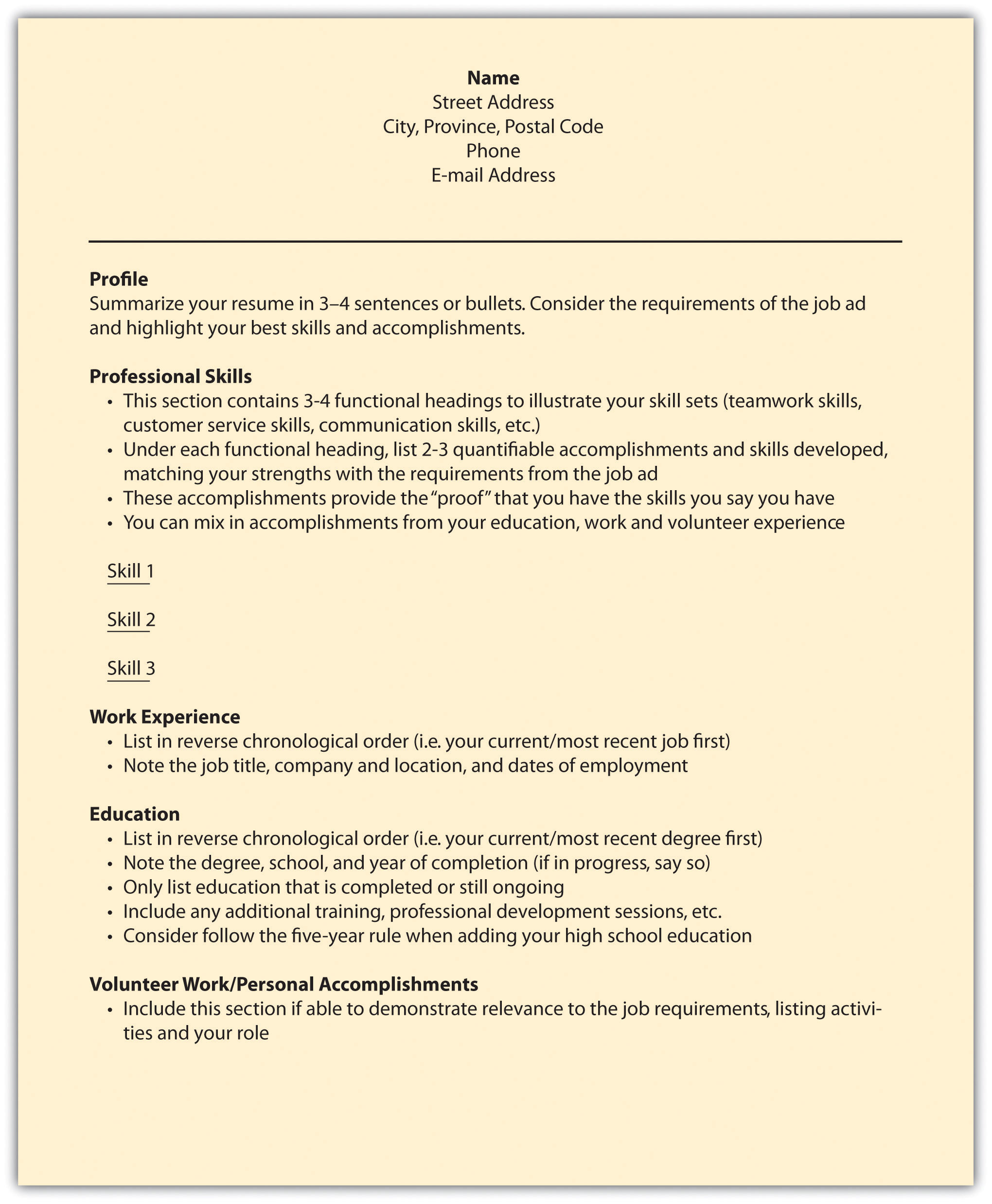
Figure 20.8 Sample Format for Scannable Résumé
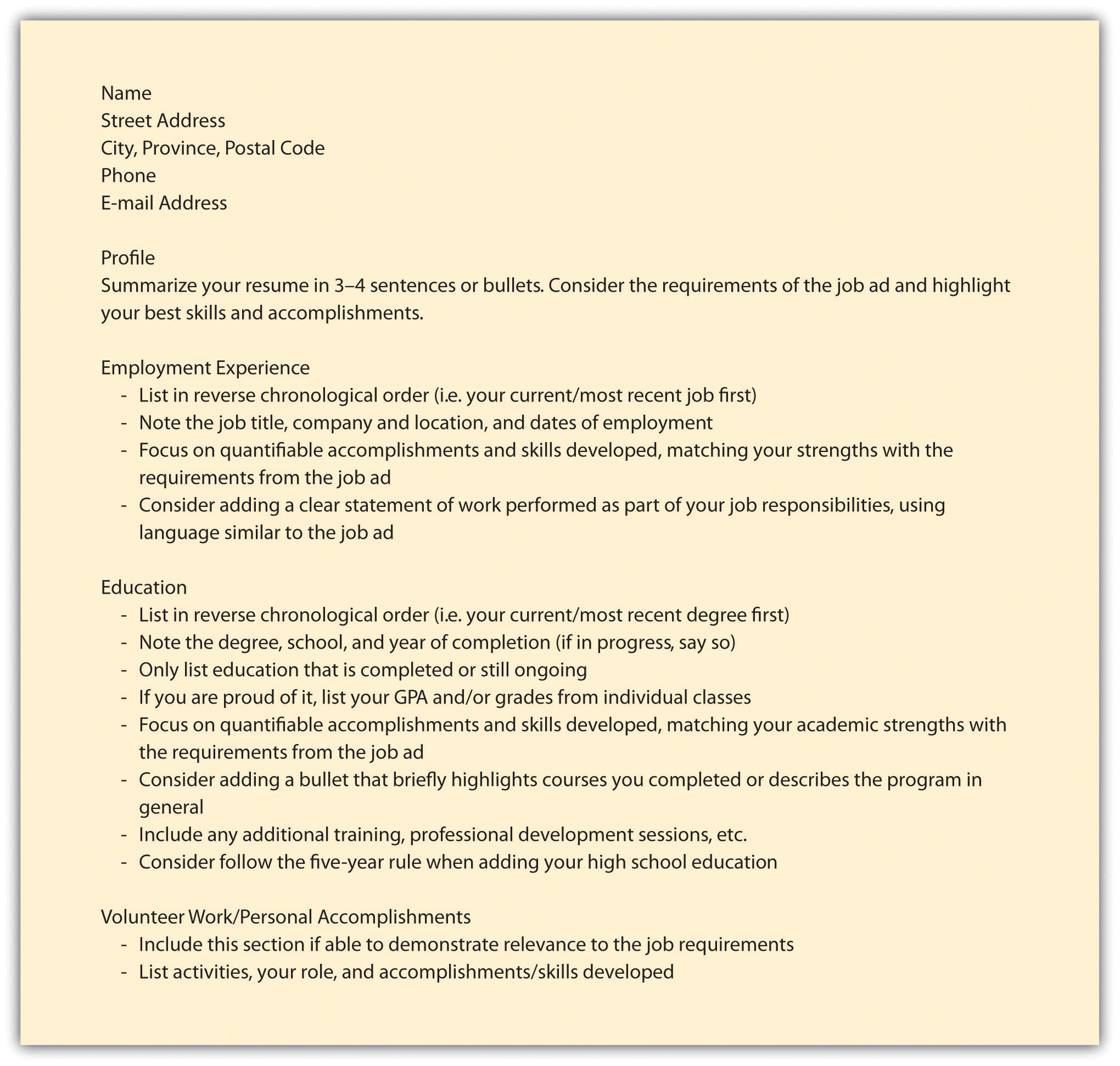
The Cover Letter
The purpose of a cover letterA letter that entices the recipient to read your résumé. is to entice the recipient to read your résumé. There is no better way to entice someone to read further than to demonstrate that you fit his or her needs. A successful cover letter should emphasize how your knowledge, skills, or experiences make you an ideal candidate.
When writing a cover letter, look over the job posting carefully. What are the keywords in the posting? Underline or highlight them. Think about how your experience and skills are related to those keywords. What examples can you give in short sentences? Now you can begin to write.
Your first strategy is to show that you are a unique and qualified candidate. This, in marketing terms, is your selling proposition. Begin with an immediate summary as to why you are the best candidate for this position. Write this opening (1-2 sentences) two or three different ways and then choose the best. If you don’t hook the reader here, you may not be considered for the job. Next, be sure to state what job you are applying for and how you found out about the position.
When you are happy with your opening paragraph, add one or two paragraphs that illustrate your proposition from the opening paragraph. Elaborate a bit on the bulleted information found in your résumé, showing how your skills can contribute to the company's needs and how you can contribute. Tell the story behind your most significant accomplishment.
Remember that your cover letter also demonstrates your communication skills. Be clear, be concise, and be careful. One typo and your application will be set aside. Be sure your spelling and grammar are correct. Did you double-check the spelling of the company name? Read the document; look for mistakes your spellchecker won’t catch (like the word “you” instead of “your”). Put it down for a while and then reread it again.
Key Takeaway
A résumé will represent your skills, education, and experience in your absence. Businesses increasingly scan résumés into searchable databases. The purpose of the cover letter is to entice the recipient to read your résumé.
Exercises
- Find a job announcement with specific duties that represents a job that you will be prepared for upon graduation. Choose a type of résumé and prepare your résumé to submit to the employer as a class assignment. Your instructor may also request a scannable version of your résumé.
- Conduct an online search for a functional or chronological résumé. Please post and share with your classmates.
- Conduct an online search for job advertisements that detail positions you would be interested in, and note the key job duties and position requirements. Please post one example and share with your classmates.
- When is a second page of your résumé justified? Explain.
- Conduct an online search for resources to help you prepare your own résumé. Please post one link and a brief review of the Web site, noting what features you found useful and at least one recommendation for improvement.




